A friend of mine recently brought this product to my attention. It looks to be acceptional value for money at an introductory price of $999.99(I'm assuming it's USD) . We are both curious about the timelapse and repeatable motion capabilities on this unit. From what I can tell, it's just a remote control speed and direction pan tilt head.
I'm wondering if anyone reading this has bought one or knows any more. If nothing else I imagine you could modify it with your own stepper or servo motors based on your moco requirements. This is the best value for money unit I have seen so far. As always, your comments are welcome.
Check out this link for more details on the PT-2100
Tuesday, August 18, 2009
Servo City PT-2100 Pan Tilt Head
Subscribe to:
Post Comments (Atom)




7 comments:
I have followed you blog for some time now and have been interested in the development of your rig as I work on my own. I was excited when you posted this link, as it was something I'm familiar with. I have not seen one of these in action, but I do have a few other products from that company and have nothing but good to say about them. That pan/tilt head is just a speed controlled motor setup that uses a pulley drive system rather than gears. Assuming each motor is 6v, like basically everything else that company makes, it does not appear to be that difficult to wire in a servo encoder, in essence, turning the motor into a servo itself. If I had an extra $1k (it is USD) laying around, I'd try it for sure.
This past week, I gave in and ordered one of these units. I received it yesterday, and upon inspection of it, it is a solid piece of work for sure. Every part on it is adjustable in one way or another using the provided allen wrench. It is built almost entirely of aluminum, with a few plastic pieces where structural integrity is not needed. The included motor movement is very smooth, but you would want to change them out for geared steppers for motion control. Even that would be no problem with the way these motors are mounted. There is almost no play in the belt drive system, so you could stick with that method and save some engineering. I found it interesting that it did not include any form of instructions, even though it is intuitive on its own. The wires only hook up one way. The box that is shown in addition to the joystick unit is actually the speed control and power box. It has four BNC connectors on it, one for each motor that joysticks can control, even though only two are used on this unit. Since it runs off a 12v, 2A power supply, you could actually run it off of a 12v car or motorcycle battery if you were not around power.
Overall, I would highly recommend this unit as a base for constructing a motion control pan/tilt head. It would be difficult to build something with this quality without a fully equipped machine shop and easy access to the materials.
I was wondering if the servo recorder/playback controller they sell on that website would work with this great pan/tilt system as a motion control rig. It sez it will "Move a knob fast and the servo will move fast, move it slowly and the servo will move slowly. In record mode it even records the time. Move the servo every 18 seconds, and in playback mode the servo will move every 18 seconds since it even records delays between servo movements. It records and plays back the exact speed, time and range of motion for each servo even at the same time."
Man this would be a great solution for me - great site btw thanx for taking the time to make it - I am also making a motion control rig but how I get there is still up in the air - Hobie
The controller can control 2 heads. You could possibly use one as a cranes base and the second as the head if the arm was counter balanced. i think this unit could handle the weight of the crane arn/head/camera specialy for dslr camera like the canon 5d markII. You can alwasy change the motor if need be.
This is great info guys. Thanks for all the responses. Keep posting!
I talked to Kyle at servocity He said they he thought the 2 head jib would work if it was counter balanced properly.
They are also releasing a roll head attachment, and follow focus support.
As far as the follow focus goes i think you will have to be able to set start and stop points and speed. Canon lens rings turn past where the focus stops so it would be cool to be able to set the start,stop and speed points of the motor from the controller.
A simple motor attached to a whip off your existing follow focus should allow for relatively easy follow focus solution.
It would be cool start a core set of preferred parts, features and principles for building out the hardware side of a motion control system for a set of defined applications like non sfx video, Timelapse, Motion control for 3D apps etc. Taking into consideration various camera sizes like DSLR and Film.
I have that servo recorder/playback unit as well, and I have thought of the same idea for making my pan/tilt unit programmable. The problem is, the pan/tilt unit is just speed controlled motors, and not servos, so there is no way to connect the recorder to it. The pan/tilt unit runs on 12v motors, and the recorder unit only handles 6v, so if you were to add encoders to the 12v motors to turn them into servos, you could only run them at a maximum of half their normal speed, which would put you at about 3 RPM. Not good for video, but may work for time lapse photography.
I had not thought about using two of these pan/tilt units to move a jib arm, but than again, you would have to have a short arm and a really light camera. I built a counterbalanced jib arm with a 4 ft. reach, and with no camera, it required 35 lbs to balance it (with a 4 lb tripod head on the end, not another 8 lb pan/tilt head). The pan/tilt head can only handle up to 40lbs before the motors just don't move at all. The more weight you add, the less accurate the motors become, not to mention, you will have already sacrificed torque by reducing the voltage in half, if using the servo recorder to control it.
Here is the recorder unit in action:
http://vimeo.com/6542257
Post a Comment